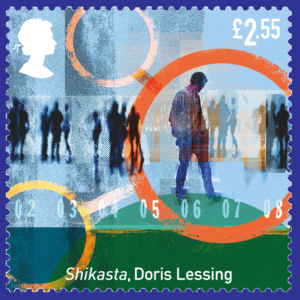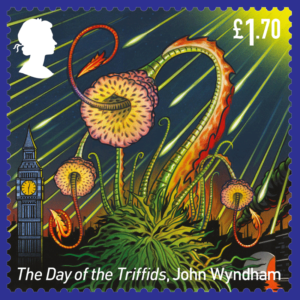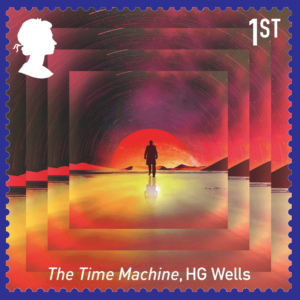[press release]
Royal Mail Celebrates Science Fiction Classics from British Authors On Six Specially Commissioned Stamp Illustrations
- Royal Mail commissioned six original illustrations for the stamp issue
- The stamps feature striking interpretations of six science fiction classics by British authors and depict key moments in the evolution of the genre
- Classics and artists in the set are:
- Frankenstein by Mary Shelley: illustration by Sabina Šinko
- The Time Machine by HG Wells: illustration by Francisco Rodríguez
- Brave New World by Aldous Huxley: illustration by Thomas Danthony
- The Day of the Triffids by John Wyndham: illustration by Mick Brownfield
- Childhood’s End by Arthur C Clarke: illustration by Matt Murphy
- Shikasta by Doris Lessing: illustration by Sarah Jones
- 2021 will mark the 75th anniversary of the death of HG Wells and the 70th anniversary of the publication of John Wyndham’s The Day of the Triffids
- Britain has been at the forefront of science fiction writing, and the writers whose work is featured on the stamps are household names the world over
- Royal Mail also worked with British writer and academic, Roger Luckhurst, on the stamp issue
- The full set of six stamps, available in a Presentation Pack, retails at £11.10. The stamps and a range of collectible products are available now to pre-order from www.royalmail.com/classicsciencefiction
- The stamps will go on general sale from 15 April 2021
Royal Mail has revealed images of original artworks being issued to celebrate six classic science fiction novels by British writers.
 The specially commissioned illustrations feature striking interpretations of the classics and depict key moments in the evolution of the genre.
The specially commissioned illustrations feature striking interpretations of the classics and depict key moments in the evolution of the genre.
The stamps are issued in the year that marks the 75th anniversary of the death of HG Wells and the 70th anniversary of the publication of John Wyndham’s The Day of the Triffids.
The classic novels and illustrators featured in the set are:
- Frankenstein by Mary Shelley: illustration by Sabina Šinko
- The Time Machine by HG Wells: illustration by Francisco Rodríguez
- Brave New World by Aldous Huxley: illustration by Thomas Danthony
- The Day of the Triffids by John Wyndham: illustration by Mick Brownfield
- Childhood’s End by Arthur C Clarke: illustration by Matt Murphy
- Shikasta by Doris Lessing: illustration by Sarah Jones
There are many stories that can point to the origins of science fiction. The satirical author Lucian, writing during the 2nd century, imagined a trip to the moon in his True History. In  1516, Thomas More proposed an ideal society, an alternative Britain, that he called Utopia. But modern science fiction is the product of societies that were undergoing rapid technological change, where the scientific world view had an authority to rival theological explanations and where there was a large, literate population that could support new forms of mass culture. These conditions were met in 19th-century Britain, but the term ‘science fiction’ came into general usage only at the end of the 1920s.
1516, Thomas More proposed an ideal society, an alternative Britain, that he called Utopia. But modern science fiction is the product of societies that were undergoing rapid technological change, where the scientific world view had an authority to rival theological explanations and where there was a large, literate population that could support new forms of mass culture. These conditions were met in 19th-century Britain, but the term ‘science fiction’ came into general usage only at the end of the 1920s.
When Mary Shelley reworked the Gothic romance to address the advances of contemporary science in her 1818 novel Frankenstein, a new literary genre was born.
From the beginning, Britain has been at the forefront of science fiction writing, and the writers whose work is featured on these stamps are household names the world over.
 While science fiction can often be considered as a lowly form of culture, full of bug-eyed monsters in flying saucers, it is also a genre that can have ambitions to engage at the highest level with emergent scientific conceptions and technologies.
While science fiction can often be considered as a lowly form of culture, full of bug-eyed monsters in flying saucers, it is also a genre that can have ambitions to engage at the highest level with emergent scientific conceptions and technologies.
There is a strong British tradition of writers who reach for these sublime heights, which this stamp issue celebrates.
Royal Mail also worked with British writer and academic, Roger Luckhurst, on the stamp issue. Roger is a Professor in Modern and Contemporary Literature in the Department of English and Humanities at Birkbeck, University of London and was Distinguished Visiting Professor at Columbia University in 2016.
The full set of six stamps, available in a Presentation Pack, retails at £11.10. The stamps and a range of collectible products are available now to pre-order from www.royalmail.com/classicsciencefiction.
The stamps will go on general sale from 15 April 2021.
Stamp-By-Stamp
Mary Shelley (1797–1851) The daughter of radicals, Shelley wrote her most famous book when she was just 19, in a famous ghost-story competition with Percy Shelley and Lord Byron. Frankenstein switched the Gothic romance from religious terror to secular scientific horror.
HG Wells (1866–1946) A young writer from the first generation of those with formal scientific training, Wells jumped into the new journals and magazines of the 1890s and helped fashion the British ‘scientific romance’ in his disturbing exploration of futures near and far.
Aldous Huxley (1894–1963) Huxley was a satirical novelist who, in horrified reaction to Wells’s outline of scientific utopia, created in Brave New World one of the most enduring novels of dystopia. He explores a future where technology oppresses rather than liberates humanity.
John Wyndham (1903–69) Wyndham captured the anxious and diminished state of England after 1945. The Day of the Triffids creates a catastrophe and then explores various ways of living in the ruins. This book was a major influence on what became known as post-apocalyptic fiction.
Arthur C Clarke (1917–2008) In ecstatic visions of expansion into outer space and evolutionary leaps for humanity, Clarke combined a longing for  transcendence with an interest in the mechanics of technology. This strand is often termed ‘hard SF’, for extrapolating possible futures from known science.
transcendence with an interest in the mechanics of technology. This strand is often termed ‘hard SF’, for extrapolating possible futures from known science.
Doris Lessing (1919–2013) A hugely versatile novelist, Lessing turned to science fiction in the 1970s to explore questions of gender, colonisation and power. Women have always been involved in science fiction, but Lessing’s generation gave the genre new avenues of social criticism.




Nice stamps. Too bad the US Stamp Program never issued their rumored SF series. The US Stamp Program also failed to issue a stamp last year for the 100th birthdays of SF legends Isaac Asimov and Ray Bradbury.
Rumor is that one or more of the estates (rights-holders) for the SF authors wouldn’t cooperate with the U.S. Postal Service. I have a feeling that other countries don’t have to ask permission or negotiate rights. However, as we’ve seen, the U.S. can be sued for intellectual property rights, successfully.